I just received this email from a student. “Hi Gene, how are you? Sorry for the FB message but I have a quick question. many years ago I did one of your courses and you taught cornering with one leg up and one leg down throughout the turn. I recently participated in an IMBA course and they promote even feet through turns. What are your thoughts on that?” Well, first off, poor coaching like this drives me nuts!
I know that they are wrong! I didn’t invent a single skill we teach but I and our coaches have spent a lot of years studying, learning and testing what we have learned from the best mountain bikers in the world (and some top motorcycle coaches). In my case, I have been studying mountain bike cornering since 1994! If your pedals are supposed to be level in corners why do the top 100 downhill racers in the world corner foot down? For all the reasons we taught you! Now don’t get me wrong if you aren’t worried about traction keeping your feet level is fine but if there is any possibility of sliding out by simply dropping your outside foot you will DOUBLE your traction! Why? Because if your feet are level 50% of your weight has to be on the inside pedal! That means 50% of your weight is not above the tires! Which means you have half the amount of down force on your tires. If that isn’t enough reason there are several more. It is really hard to separate from your bike with your feet level so you tend to lean with your bike taking even more weight off the tires. Also by dropping your outside foot you get 155-175 mm of extra leverage on the tires and lower yourself to the ground. Because your bike leans when it turns you also get more ground/rock clearance for the inside pedal by dropping the outside.
Greg Minnaar can corner pretty good, he has won 3 World Championships and 3 World Cup Overalls he often corners foot down! As in the photo below from one of our camps with him.
Now, before we go any further talking about foot placement when cornering, remember, the most important part of cornering is vision! If you are doing what 99% of mountain bikers do in corners, looking only a few feet ahead, foot placement is the least of your worries. Looking through a corner with incorrect foot placement is much faster and safer than looking only a few feet ahead with perfect foot placement!
As you know, we are famous for coaching mountain bike cornering to some of the best cornerers in the world*. Why? because we studied it! We didn’t say, “I corner really well and this is my opinion”. We studied the best mountain bike racers, we worked with World Champions like Greg Minnaar and Marla Streb, we took motorcycle cornering courses, we studied cornering like our life depended on it! Don’t believe me? Go to Red bull dot com and watch the world cup downhill races, you will see that on fast, loose corners 100% of the field is dropping their outside foot. When traction is not an issue or the speeds are slow they will keep their feet level, not because they have too but because there is no need to drop their foot. Now, if they are trying to increase their speed by pumping the corner their feet will be level (a skill we teach in our graduate camp and our downhill camps) as if you are trying to increase speed in a corner you are obviously not worried about traction. In short, we teach cornering foot down because it works, if you dropped your foot when you didn’t need to no harm if you keep your feet level when you should have dropped your outside foot you will crash! I hope this helps. You might think of asking for your money back for paying for coaching that puts you in danger.
The long story, there are numerous different foot positions for cornering and for entering corners but we don’t want you thinking, “is this a foot level corner or foot down corner?”. By coaching our students to corner foot down we have found that they tend to simply keep the feet level when there is no need to drop the outside foot, much better than thinking!
* National Four Cross and Downhill Champion Mitch Ropelato, 2014 National Dual Slalom Champion Luca Cometti, 2014 Sea Otter Dual Slalom Champion Cody Kelly, Nation Downhill Champion Jackie Harmony, Collegiate Champion and Yeti Ace Joey Schusler, and over 100 more Pro Downhill Racers and Pro XC racers! As a matter of fact Dirt Magazine asked Mitch Ropelato how he corners so well and he had this to say: From the Oct. 2009 issue of Dirt Magazine:
Dirt Magazine: “You seem to be able to turn amazingly, what do you put that down to? Got any special tires on there?
Mitch Ropelato: “Ya, Gene Hamilton is to thank for that, I took is clinic last December in Bootleg Canyon and he was able to show me the correct technique I needed to pull them off.”
Stay tuned next week for part two cornering foot placement!

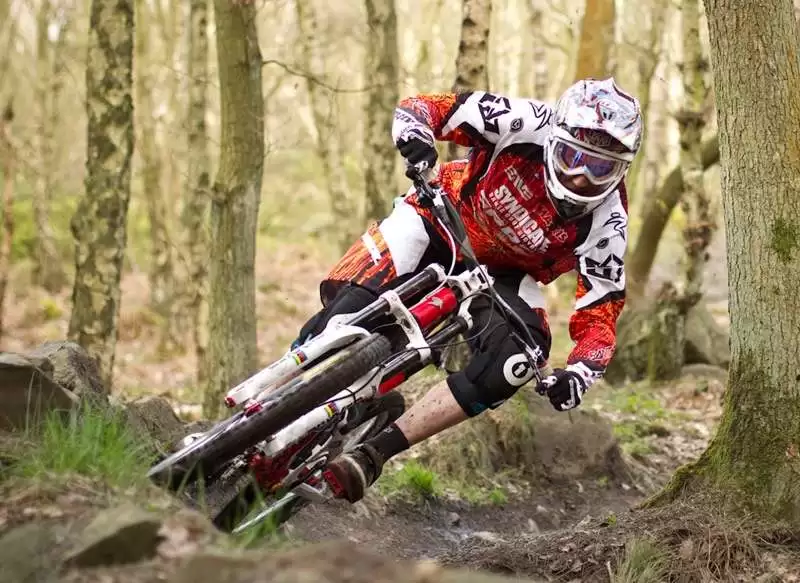
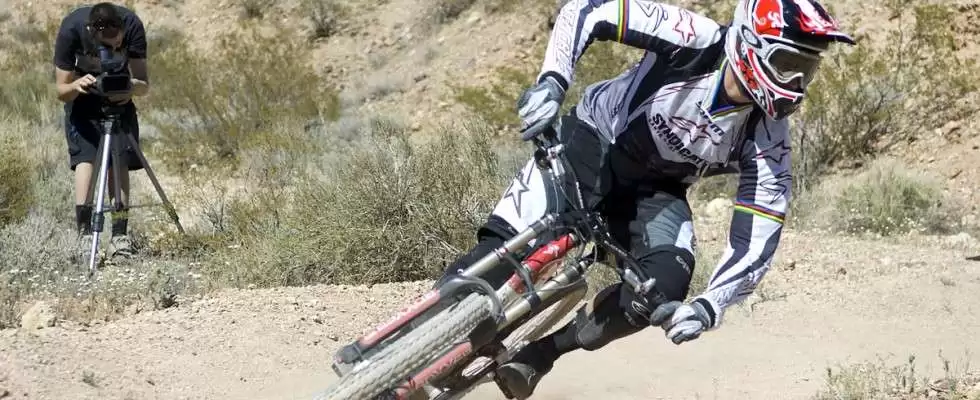
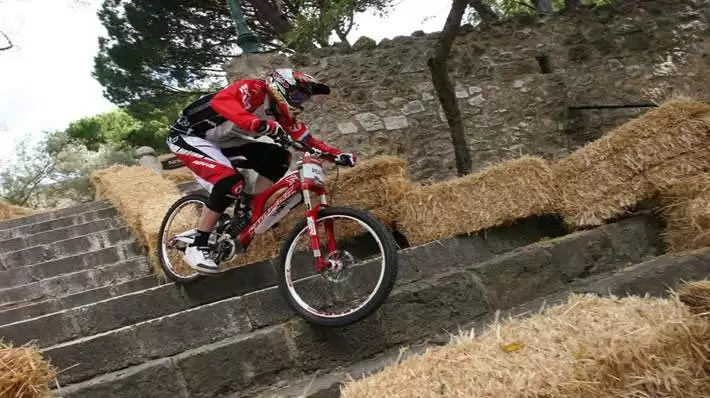
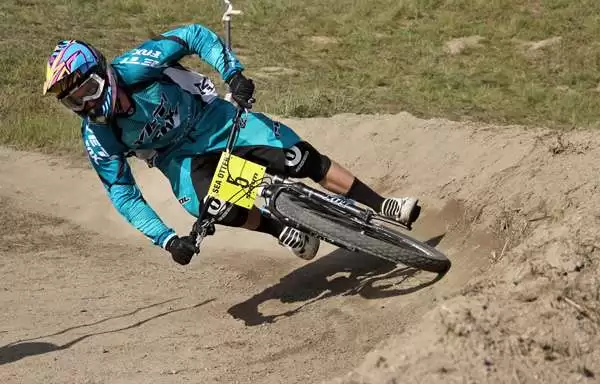
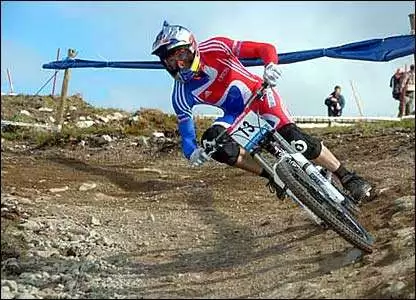
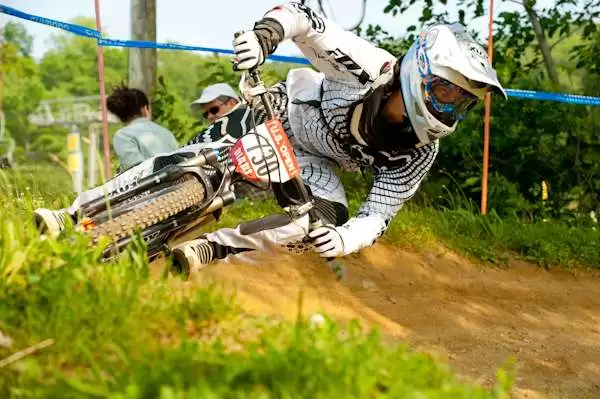
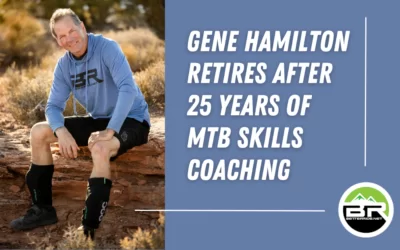
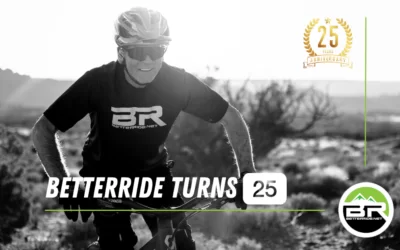
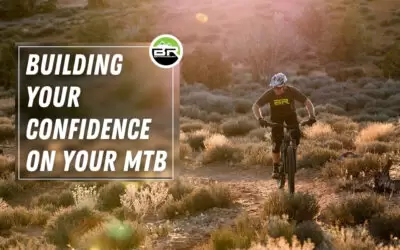
Hey Gene, glad to see you weigh in on this. I took the IMBA ICP Level 1 course recently and can confirm that their recommendation is level pedals when cornering. My recollection of the rationale given was that total weighting of the outside foot in a corner (foot down position) tends to straighten the bike when it’s leaned over. My informal testing of that is that it’s true up to a point, but once the lean is significant, the bike no longer tends to straighten. Something going on their with physics, I’m guessing!
But the other issue I’m wondering about is a rider’s ability level. While it may be best for advanced riders to corner with their outside foot down, is it best to instruct beginner and intermediate level riders to do it? It does add an additional level of complexity for them rather than just riding with their feet level. And related, might it be best for beginner and intermediate level riders to first focus on bike lean and maybe even hip flexion before they progress to pedal position? I’m not arguing, just wondering!
I think there is a misunderstanding of term here. Everyone of those photos shows riders with level pedals per the imba definition. They teach level pedals level RELATIVE to the ground. Draw a line through their pedals and it will be parallel to the ground. That gets you maximum traction and stability. Saying outside pedal down tends to result in riders locking their outside leg on every turn, which is neither balanced or stable.
Hi Scott,
That is simply not true, in some of the photos the outside pedal is clearly lower and it has 100% of the riders weight on it, both are “wrong” according to the IMBA school. ““The ICP philosophy is that a rider who maintains a solid stance will be able to control the bike under all conditions. We want our riders to stand on both feet using equal pressure…”
from https://www.imba.com/blog/tammy-donahugh/just-around-corner#sthash.B1u37oHB.dpuf.”
“My recollection of the rationale given was that total weighting of the outside foot in a corner (foot down position) tends to straighten the bike when it’s leaned over.”
I believe this will only be the case if you are not shifting your weight (hips) while attempting to lean the bike. In other words, it will be very difficult to corner with the outside foot down while shifting your weight and not push the bike in the opposite direction or lean the bike.
Corey, you may be right. And the more I read about this, the more I think it’s hip flexion/torso rotation that’s more important than pedal position, especially for flatland turns. Seb Kemp writes:
http://nsmb.com/5214-hey-coach-ep-1/
“Side Note: Foot Position. Some people tend to drop their outside foot (Steve Peat, Cedric Gracia and myself) whereas others will appear to keep their pedals pretty level (Sam Hill and Darren Butler) and others play for both teams. As long as you are driving your body weight into the tires.”
Exactly Griff, vision is more important than anything, then staying on top of your bike, then hip flexion/torso rotation. Although we coach all the little details of every skill we teach we make sure our students know what is a big picture skill (greatly improves your riding) and a little picture skill (improves your riding IF you are doing the big picture skills correctly (more on that in my next foot position article) foot position is in between the two, a medium picture skill.
However, you absolutely have to drop your outside foot and put 90 to 100% of your weight on that outside pedal to get the maximum amount of traction and the right lean angle for corners requiring a drastic lean angle and maximum down force on the tires. Again, more in my next article!
Thanks for your input!
Cheers,
Gene
P.S. Sam Hill drops his outside foot, a lot!
Thanks, Gene. In part 2, can you address the differences between a bermed corner vs. a flat corner re: pedal position/weight distribution?
Yes I can Griff!
As long as you are balanced and in good position driving your weight through the bottom bracket, you may not need to be fully at 12 and 6. If you look at Peaty on those stairs (sick, btw), his feet are at the 1 and 7 position.
For those wondering, Andy spent 3 solid hours with us on just “cornering” in the Better Ride camp. Elbow position, bike position, counter-steering, hip placement, eye placement, approaching and exiting position, AND pedal position… all while balancing a glass of water on your head. Who knew turning a bike could be so involved? lol.
“Involved” indeed, Jason. It’s like a pro golf instructor analyzing everything that goes into a pro’s swing. TOO MUCH INFORMATION!
IMBA Instructor Certification Program manager Tammy Donahue has a new blog post titled:
Shaums March Talks About Cornering Technique in response to Gene Hamilton’s criticism:
https://www.imba.com/blog/tammy-donahugh/just-around-corner
“Recently, long-time MTB coach Gene Hamilton wrote a blog post about cornering technique. He was overtly critical of the technique that the ICP program teaches, prompting many instructors and riders to send e-mails to the ICP inbox asking for more information about why we favor a level-pedal foot position, rather than teaching students to keep the outside pedal down.”
Ironically, every rider in Shaums list uses Gene’s technique.
Example: In this video you can see that Richie Rude is using outside pedal down on every single corner .
http://www.youtube.com/watch?v=vKfETOwtkNI
Jason, please post the video or email us a a link.
Thanks,
Gene
“The ICP philosophy is that a rider who maintains a solid stance will be able to control the bike under all conditions. We want our riders to stand on both feet using equal pressure…”
from https://www.imba.com/blog/tammy-donahugh/just-around-corner#sthash.B1u37oHB.dpuf.
I can’t really think of any athletic endeavor, be it golf or soccer or skiing (a good analogy used by a facebook commenter) where you are not required to shift your weight from one foot to the other as well as be balanced between the two depending on the motion. The primary difference that I observe and practice for appropriate weight distribution is basically broken down to 2 physical states; ready position and attacking.
Ready position: weight evenly distributed, knees bent, lower center of gravity, etc., able to react as needed.
Attacking: Weight shifted as needed, maintaining low center of gravity because I’ve shifted my weight appropriately, but placing my body in a position to follow through with whatever motion that I’ve initiated as well as be able to react to changing conditions. Bearing in mind that good attack has to be initiated from a good ready position.
Using the golf analogy (primarily because it seems to be so far removed from mountain biking, but I am trying to illustrate that the same principles apply) I address the ball with my weight evenly distributed, knees flexed, my body somewhat relaxed, but prepared for action. As soon as I initiate that action, the swing, if I do not shift my weight to maintain good balance and proper positioning, a train wreck will ensue. Mountain biking, approaching the corner, good ready position; entering into, continuing through the corner (attacking), weight HAS to shift appropriately for the motion.
TL;DR: if you never have to turn your mountain bike then, by all means, keep your weight evenly distributed.
Please note,I have never taken one or their courses, so my response is based solely on their particular blog post. Although I do find it ironic that they acknowledge that, “good cornering technique is more complex and dynamic than that,” in referring to pedal position, yet state that it can be simply addressed with evenly weighted pedals.
Right on Corey!
Hi,
there is no difference in traction between equal weight on pedals and all weight on the outside foot. Just ask a physicist. When you step on a scale and lift one foot, all your weight will be on the other foot and but you will still weigh the same. In the case of the bike, the contact with the ground are both tyres. Only the tyres create traction. The tyres will be pressed onto the ground with the same force in both cases (one pedal all weight or equal weight both pedals) thus resulting in the same traction. The only thing, that may change, when you put all your weight only on your outside pedal is, that you may need to tilt your bike more to stay in balance.
This tip has helped me so much! Thanks for the article. Especially in downhill switchback turns.